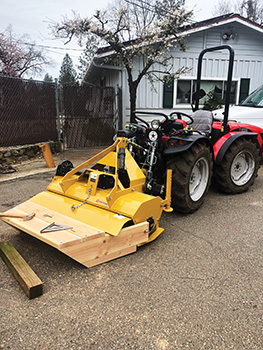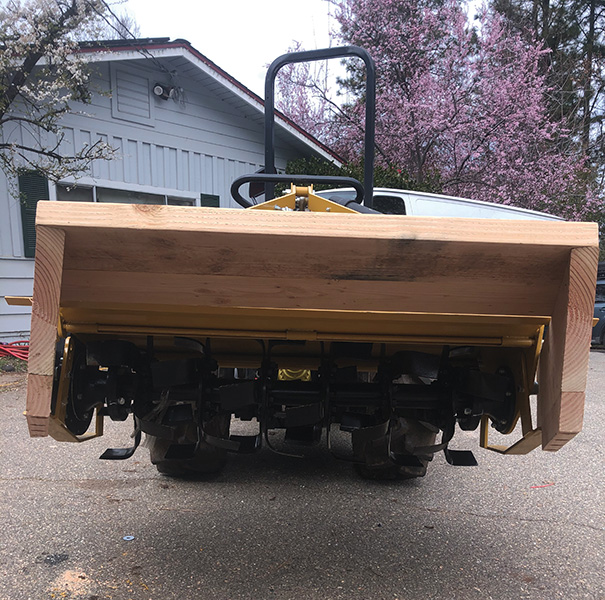Post your farm-made tool on Instagram or Facebook with #toolsforgrowingformarket. If author Josh Volk picks your tool, you win a $50 tool gift certificate and a Full Access subscription to GFM.
Two simple modifications to common farm tools caught my eye with the #toolsforgrowingformarket hashtag this month: A salad harvester made from a set of classic hand shears, and a wooden bed shaper mounted on a rototiller. These were both older posts on @starbrightacresfamilyfarm’s Instagram account, but they were good enough to go back and add the tag so we can all find them easily (hint, hint – you can go back and tag old photos of tools you like that you’ve already posted so we can see what’s working for you!) I talked to Ken from Starbright Acres Family Farm in Grass Valley, California, to get a few more details on the tools and how and why they work for their farm.
 The back side of shears with stainless sides tack welded to the blade.
The back side of shears with stainless sides tack welded to the blade.
The salad harvester is a classic set of sheep shears with a bit of stainless sheet metal added to make sides that hold the greens as they’re cut, and a back to keep the cut greens from falling out the back of the modified shears as they’re being cut. This allows one-handed harvesting, leaving the other hand free to move the harvest container along while the cutting hand alternates between cutting 4-8 inches of row at a time, and dumping the collected harvested greens in the harvest container. You can check out a video of the process on their Instagram.
 Cutting lettuce with the modified harvester.
Cutting lettuce with the modified harvester.
Ken has tried the drill powered salad greens harvesters, and others, but for the last eight years this has been their salad harvest tool of choice as it allows more control of the harvest in the bed and is more comfortable to use. If there are weedy sections, they can skip around those, and the tool is far lighter weight with less exposed blade, both making it less likely to cause injury for the user.
The idea for the tool came to Ken from another farm that used a similar design, only with hedge shears that required two hands to operate. Ken had a friend weld the stainless sides to the smaller shears for one handed use. After 8 years of regular use the shears are starting to wear and dull. They’re difficult to sharpen due to the sides getting in the way of blade access, but he’s sharpened them with a Dremel bit on a drill to give them a bit longer life.
 The wooden bed shaper mounted on the back of the rototiller. This photo was taken before the support chain was added.
The wooden bed shaper mounted on the back of the rototiller. This photo was taken before the support chain was added.
The bed shaper also builds on ideas gleaned from other farms. The farm started as a small market garden with about ¾ of an acre in production and using BCS walk behind tractors. They’ve since expanded, now farming over 3 acres and incorporating a four-wheel tractor as well. Ken looked at buying a purpose-built bed shaper for the four-wheel tractor, but the price tags made him consider building his own. He ended up purchasing an inexpensive rototiller and then built a wooden shaper off the back, taking tips from many of the DIY designs available online. The shaper holds the usual rear gate open and funnels the 4’ tiller width down to a 30” raised bed top with the sides of the bed sloping down into the pathways.
 The underside of the wooden bed shaper.
The underside of the wooden bed shaper.
The shaper is made from simple 2x8 lumber. Ken bought extra-long bolts to replace the ones that held the depth skids in place and used those bolts to also hold on the side pieces of the shaper. Stacked washers take up the space that the angled board makes, and he uses Nyloc nuts to make sure they don’t come loose.
To hold the top pieces of the shaper on he used sturdy lag screws. A chain held on with eye bolts, similar to the one for the rear gate, holds up the shaper. The side boards weren’t deep enough, so he ripped some 2x8’s to add on a couple of inches, allowing the shaper to raise the beds up almost 10”. The side boards are also cut at an angle at the exit of the funnel, which is what angles the shoulders of the bed, helping keep it from collapsing as it’s formed.
 The beds shaped by the modified tiller.
The beds shaped by the modified tiller.
At this point the shaper has been used for two acres of beds and isn’t showing any real wear. To get it to work Ken found he needs to put about 150 pounds of down pressure on the wooden shaper, and in the short term he’s been using 50lb fertilizer bags, but in the long term he’s looking at replacing those with steel weights. The farm’s beds are on 4’ centers so the rototiller covers the bed top and half of each pathway in a pass. Ken has also wondered if a 5’ tiller width might have worked better, allowing the tiller to work more of the pathway on either side of the bed in a pass.
I like the relative simplicity of both of these farm-built tools. There’s a silly aphorism in the cycling world, “steel is real,” which is generally meant to promote steel as a bicycle frame building material over other more “exotic” materials. Might be just as appropriate in this case to say, “wood is good,” to point out that on small scale farms, steel isn’t the only material for effective tools in the field.
Josh Volk farms in Portland, Oregon, and does consulting and education under the name Slow Hand Farm. He is the author of the book Build Your Own Farm Tools and Compact Farms: 15 Proven Plans for Market Farms on 5 Acres or Less, available from Growing for Market. He can be found at SlowHandFarm.com.
